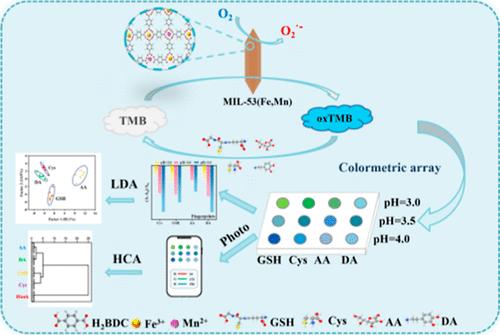基于双金属-有机骨架MIL-53 (Fe, Mn)的纳米酶比色传感器阵列鉴别生物抗氧化剂
IF 3.9
2区 化学
Q2 CHEMISTRY, MULTIDISCIPLINARY
引用次数: 0
摘要
生物抗氧化剂在许多疾病相关的生物过程中起着至关重要的作用,这导致了对其鉴定的极大兴趣。在本研究中,创建了一种比色传感器阵列。它使用MIL-53 (Fe, Mn)纳米酶同时检测多种抗氧化剂。采用溶剂热法制备了双金属纳米酶MIL-53(Fe, Mn)。该框架具有明显的类似氧化酶的催化能力。特别是在不同的pH条件下,它有利于无色TMB向蓝色化合物的转化。当抗氧化剂被引入反应体系时,传感器阵列表现出交叉反应性,产生不同的颜色信号。利用线性判别分析(LDA)成功地对不同浓度的半胱氨酸(CYS)、谷胱甘肽(GSH)、多巴胺(DA)和抗坏血酸(AA)及其组合进行了精确鉴定。这种方法能够准确地测定这些物质单独和混合的量,为在实验环境中分析它们的浓度提供了一种可靠的方法。此外,所制备的传感器阵列与智能手机相结合,成功地区分了血清中的目标抗氧化剂。所提出的传感方法有望在诊断中有实际应用。本文章由计算机程序翻译,如有差异,请以英文原文为准。

Nanozyme Colorimetric Sensor Array Based on Bimetal–Organic Framework MIL-53 (Fe, Mn) for the Discrimination of Biological Antioxidants
Biological antioxidants play a crucial role in numerous disease-related biological processes, which has led to significant interest in their identification. In this research, a colorimetric sensor array was created. It uses MIL-53 (Fe, Mn) nanozymes to simultaneously detect multiple antioxidants. The bimetallic nanozymes, MIL-53(Fe, Mn), were synthesized by using a solvent-thermal method. This framework demonstrated notable oxidase-like catalytic ability. In particular, it facilitates the conversion of colorless TMB to a blue compound under different pH conditions. When antioxidants were introduced into the reaction system, the sensor array exhibited cross-reactivity, resulting in distinct color signals. Linear discriminant analysis (LDA) was successfully utilized to precisely identify the different concentrations of cysteine (CYS), glutathione (GSH), dopamine (DA), and ascorbic acid (AA) and their combinations. This method enabled accurate determination of the amounts of these substances both individually and in mixtures, providing a reliable way to analyze their concentrations in an experimental context. Furthermore, the prepared sensor array combined with the smartphone successfully distinguished the target antioxidants in the serum. The proposed sensing method would be expected to have practical applications in diagnosis.
求助全文
通过发布文献求助,成功后即可免费获取论文全文。
去求助
来源期刊

Langmuir
化学-材料科学:综合
CiteScore
6.50
自引率
10.30%
发文量
1464
审稿时长
2.1 months
期刊介绍:
Langmuir is an interdisciplinary journal publishing articles in the following subject categories:
Colloids: surfactants and self-assembly, dispersions, emulsions, foams
Interfaces: adsorption, reactions, films, forces
Biological Interfaces: biocolloids, biomolecular and biomimetic materials
Materials: nano- and mesostructured materials, polymers, gels, liquid crystals
Electrochemistry: interfacial charge transfer, charge transport, electrocatalysis, electrokinetic phenomena, bioelectrochemistry
Devices and Applications: sensors, fluidics, patterning, catalysis, photonic crystals
However, when high-impact, original work is submitted that does not fit within the above categories, decisions to accept or decline such papers will be based on one criteria: What Would Irving Do?
Langmuir ranks #2 in citations out of 136 journals in the category of Physical Chemistry with 113,157 total citations. The journal received an Impact Factor of 4.384*.
This journal is also indexed in the categories of Materials Science (ranked #1) and Multidisciplinary Chemistry (ranked #5).
 求助内容:
求助内容: 应助结果提醒方式:
应助结果提醒方式:


